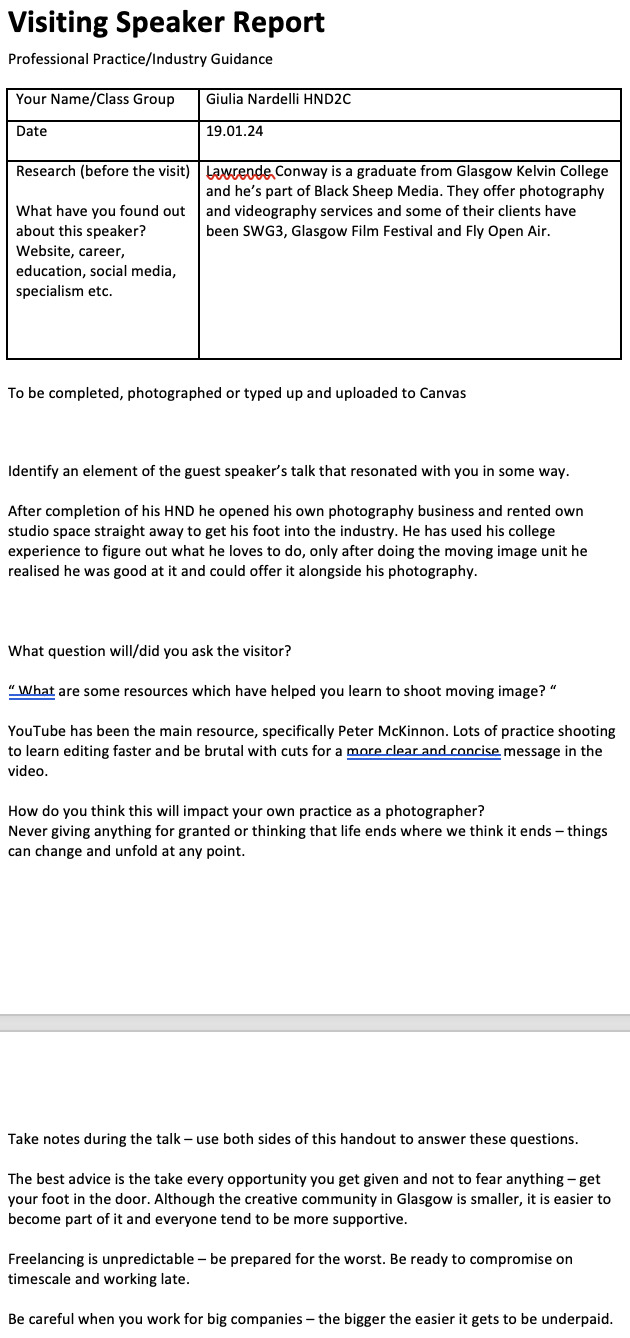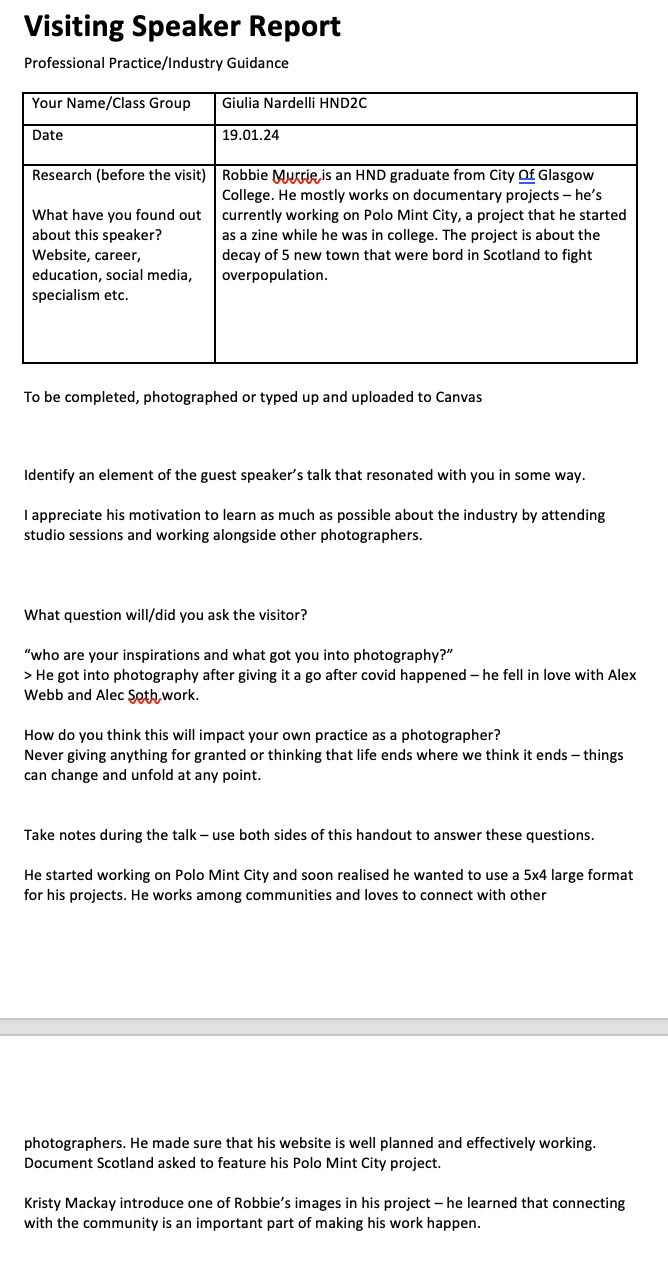Text
Creative Industries - Culture Quiz
>Who is Minister for Culture in the Scottish Parliament? - Kauai Stewart
>Who founded the Young Photographer’s Alliance? - Jerry Savin and Deborah Free in 2009
>Who is the CEO of Creative Scotland? - Iain Munro
> What is the name of the Cultural Enterprise Office’s training programme for young creative entrepreneurs? - Design Your Practice (DYP) is a programme which allows creative freelancers to establish their practice and proactively take control of their future.
>What is the address of Business Gateway in Glasgow? - Address: Exchange House, 231 George St, Glasgow G1 1RX
> List 6 creative businesses in Glasgow. - MadeBrave (creative agency) - FishFinger (creative agency) - Freytag Anderson - Dog Digital - Hug - Warrior >Name two photographic galleries in Scotland. - Street Level Photoworks, Glasgow photography gallery, Agitate Gallery, Still Gallery >Where do the following cultural events take place, what do they promote and who is the Director of each? - Glasgow International Document Festival: Glasgow; Richard Birkett (2022) - EIFF: Edinburgh; Paul Ridd (2023) > Name a Stills photographer working in the film Industry in Glasgow? -Julie Bradford
> List four places where you could have your photographs professionally printed in Glasgow: - Deadly Digital - Loxely colour - Black art Giclee - Make Works
> Which Photographic magazine publishes the shortlisted photographers for the Jerwood Photography prize? - Photoworks
If you were involved in a fashion shoot at Film City, what kind of building would you be in? - Victorian Govan Town Hall
List 3 Scottish based agencies where you might hire a model for a photoshoot. - Colour agency, All Talent Agency, Model Team
Name three magazines devoted to the promotion of ‘new photography’. > Crack, The Skinny, fStopMagazine
0 notes
Text
Comment on the following sectors:
> Advertising: Sales, Marketing, Creative development
>Arts and Culture: Photographer, curator, creative direction, editor, owner of an art gallery
> Design - job roles: Interior designer, creative director, design director, UI designer, motion designer
> Fashion industry – job role: Photographer, social media manager, assistant technical designer, pattern company designer, designer, head designer, design department head, and creative director.
> TV and Film – job roles. Script editor · Casting assistant · Casting director · Commissioner · Development producer (Filmand TV Drama) · Director (Film and TV Drama) · Executive Producer
>Publishing– job roles. Jobs in publishing: the roles | Editorial | Design | Production | Contracts | Rights | Marketing | Publicity | Sales | Print buying | Distribution | Supporting roles
>Music and performing arts– job roles. Types of jobs in the performing arts · Director · Producer · Screenwriter · Stage manager · Choreographer · Set designer · Theatre technician · Sound designer
> Games design and digital media. Gameplay designer, animator, Games Publisher, Level designer, Game tester
> Medical photography forensic photography
0 notes
Text
How photographers could interact with other sectors within the creative industries.
Photographers could work along with: > Cinematographers > Choreographers > Make up artists > Fashion designers > Interior designers > Nightlife/Music industry
0 notes
Text
Roles and Opportunities available with the Photo Imaging Sector of creative industries
Professional photography within the UK has shown in a study by IBIS World that every year for the next 5 years there will be a 2.2% rise and it is believed from that study around 1.7bn between 2018/2019 will be made in the UK economy. This projection is estimated to bring around 8000 business and close to 18000 employees within the section photography lies over the next 5 years. The photography industry is broken down in to various sub categories I found various websites with similar information, but the list below was gathered from George Baily on Photodoto (Bailey 2012 www):
Fashion
Landscape
Wildlife
Areal
Sports/Action
Pets
Events
Architecture
Astro
Photojournalism
Macro
Medical/Scientific
School/Graduation
Baby/Family
Satellite
Advertising
Travel
Street Photography
Wedding
Stock
This list could be more extensive as there are smaller photography groups within each of these headings such as advertising you could include food, clothing, foot ware etc. The above list seems to be the main types of photography that are around in the UK today. When reviewing each sub section many of these photography groups interlinks with one another. What I mean by this is that you may have a photographer who specialise in portraits, say it was photographing adults, but with this expertise you could include photographing children, babies, pets etc. If you were to delve even further with the portrait area of photography you could include weddings, fashion, street photography, events, etc as they all involve people who you will position and pose to create your images. What I have seen from my research is that as a photographer you can interlinks your skills to fit in with your chosen field no matter what you shoot or are hired to do.
0 notes
Text
Contribution to the UK economy
I found that on the Scottish Government website stating that the definition of the Creative Industries was “Creative Industries are those which have their origin in individual creativity, skill and talent. They also include industries which have the potential to create wealth and jobs through the development, production or exploitation of intellectual property” (Scottish Government 2011 www).
The current study on the government website for the Creative Industries indicated its worth as £91.8bn back in 2016 (Department for Digital, Culture, Media & Sport 2017 www). In 2015 UK exports where £21.2bn, showing a growth of around 9.4% and from these figures a predicted calculation for 2020 has indicated this could rise too £31bn (Creative Industries Council 2014 www). These changes to the UK’s past exports of labour industries such as steel, coal, car manufacturing etc, will hopefully secure the UK’s future in the world in a creative way to insure a healthy growth to the economy which will create job security and business growth. Other studies from Prospect have stated that there are around 2 million jobs to date but by 2030 the Creative Industries could in fact create around a further million, indicating the potential for growth is endless (Smith 2017 www).
The Creative Industries has been bringing in a significant amount of money back into the country and have created more opportunities to strengthen the economy. If you look at the chart from Creative Industries Council sub-sector where Film, TV, video, radio and photography you can see the growth in the past 7 years has gone from £12,793,000 to £15,361,000 which is a rise of 20.1% that has added 0.9% to the GVA (Gross value added) of the UK economy (Creative Industries Council 2016 www).
0 notes
Text
Creative industries - Introduction/history
Creative industries is an umbrella term that covers a ran of sub sectors that all have creativity at their core. Careers in the creative arts are popular as they span a range of disciplines from arts, culture, design and media.
The creative industries are vital to the UK economy - they employ over two million people and are faster growing than other industries.
It's difficult to pinpoint accurately when this sector of the economy was born, but we could consider the year 1998 to be pivotal in changing the reputation and consideration of the creative and cultural sectors, their value and their contribution to the UK. At this time, the Creative Industries mapping Document was published by
In 1997, when New Labour took power, the Blair government renamed and reorganised the Department of Natal Heritage was the Department for Culture and. Media. and sport (DCMS). It was within this context that the Creative Industries Task Force was born. The idea came from Chris Smith, appointed by Blair as the Secretary of State for Culture, Media and Sport.
The task force was aiming at providing a coherent overview of the structure of these sectors as they felt as it was overlooked by the government. They wanted to make the creative disciplines an active sector in the UK economy and not simply a "nice to have".
1 note
·
View note


